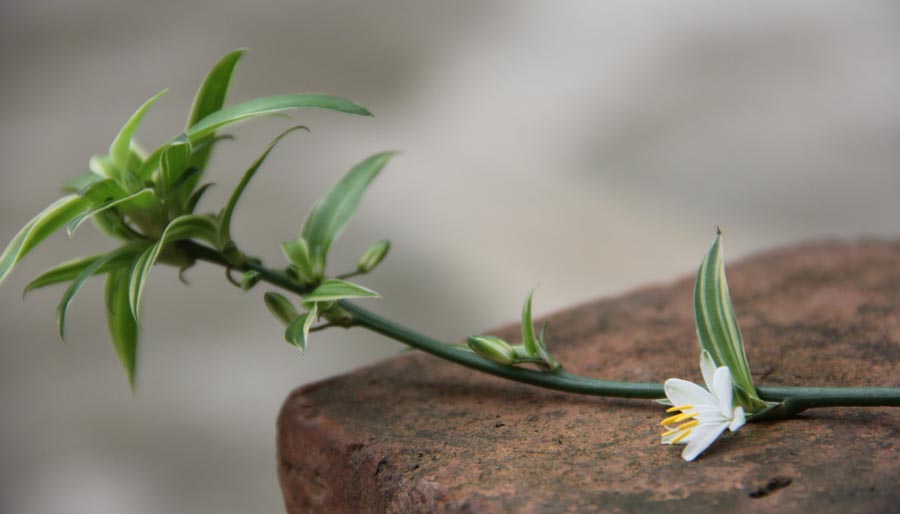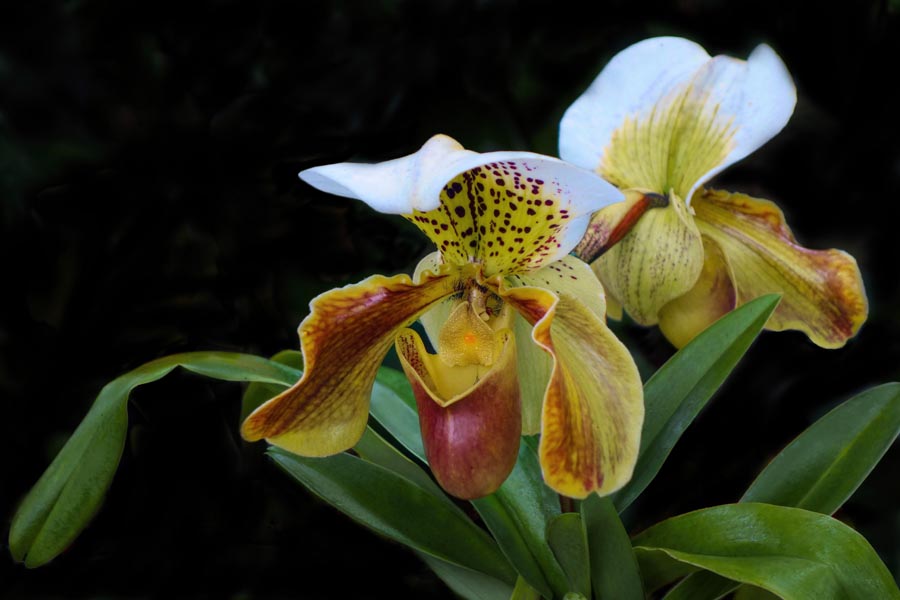
Why are my orchid leaves turning brown? I hear you ask.
We know that light to medium green colored leaves are a sign that an orchid is happy and healthy, so when we notice them discoloring it can be frustrating and puzzling.
If you notice the leaves of your orchid turning brown it indicates that something is wrong.
But don’t worry, with a little care or attention you can usually fix the problem.
So let’s get started.
Why Are My Orchid Leaves Turning Brown?
The leaves of an orchid could turn brown for a number of reasons, but more often than not it is due to one of the following: too much or too little water, too much direct sunlight, too much or too little fertilizer, an infection or pests attacking the orchid. Usually, the problem can be resolved.
Reason #1: It is a Sign of Root Stress
If you notice the tips of the leaves of your orchid in particular turning brown, this could be a sign of vascular stress often related to the roots.
There are many possible reasons for this stress including:
- Too much water
- Too little water
- Poor water quality
- Too much fertilizer
- Poor potting mix
- An infection
If the roots of your orchid are in bad shape, then this will be reflected in the appearance of the leaves.
No matter how much care or attention (or fertilizer!) you give an orchid, if the roots are not in good condition it will have no benefit.
It is a case of identifying the exact problem, examples of which we have outlined below, and then taking appropriate action.
Reason #2: It Could Be Root Rot From Overwatering
Orchids like to dry out between waterings.
Even if the instructions tell you to water your orchid once a week you should only do so when the medium is dry.
If the potting media gets too wet, and there is water sitting inside the pot, it will cause the roots to rot which will dehydrate the plant.
This in turn can lead to brown spots on the leaves
RELATED ===> Why Do Orchid Leaves Curl?
Also when you water take care not to get water in between the leaves or on the crown.
This can cause stem rot or crown rot, usually noticeable by the tissue turning black or brown and feeling much softer than normal.
If your orchid is suffering from root rot, remove the dead roots and anything else that is rotting and place it in well-drained media. Keep the humidity high and new growth should eventually start.
Reason #3: It Could Be A Fungal or Bacterial Infection
Expanding on the point above, if it isn’t stem or root rot, then brown spots on your orchid leaves could be a sign of another type of infection.
Small circular spots usually represent a fungal infection, large soft brown areas are indicative of a bacterial infection.
Again trim off dead roots and any part of the plant infected and repot your orchid in well-drained soil.
Reason #4: It Could Be A Drainage Issue
Linked to reason #2, whilst you might be watering your plant sufficiently if they are potted and there is not adequate drainage the water might accumulate around the roots.
Remember by nature orchids are arboreal and need a lot of air circulation around their roots as well.
Ensure your pot allows water to drain out and plenty of air can get to the roots of your orchid.
Reason #5: It Could Be A Sign of Dehydration

When the tips of an orchid turn brown, it can often be a warning that the plant has not been getting enough water and the entire leaf might die.
If you increase the regularity of watering and the problem still doesn’t cease, it is likely the roots have stopped functioning and are no longer absorbing water.
Remove dead roots, repot and ensure you water regularly and keep an eye on the progress of the orchid.
Reason #6: It Could Be A Sign Pests Are Attacking Your Orchid
If you notice yellow or brown spots, shriveled foliage or purple lesions on leaves it is a sign your orchid might have some unwanted visitors.
Like many other plants, orchids are inviting places for all kinds of pests.
Try using a fungicide treatment that is foliar, such as Thiomyl to combat the problem.
If you remove the diseased leaf, even if only a small portion is affected, it will stop the plant from nourishing the infected leaf and depriving healthy parts of the orchid of vital nutrients.
Reason #7: It Could Be Sunburn
Leaves turning yellow and brown, or even going black and drying out is a sign your orchid is suffering from sunburn.
Remember orchids are epiphytes (they grow in trees) and as such, they are used to dappled sunlight, not direct sunlight.
RELATED ===> Why Is My Orchid Growing Leaves Instead Of Flowers?
If your orchid is inside and you want to keep it near a window, place it near a south or west-facing window. Keep a close eye on it in the afternoon. making sure it doesn’t get direct sunlight when the sun is high in the sky.
You can also try putting a shade cloth or thin curtain between the window and the orchid to take the edge off of the sun.
Reason #8: It Could Be A Sun Tan

Orchids produce a protective pigment called anthocyanin that guards the plant against stresses from light and from cold temperatures.
If you notice the leaves look healthy, but with a brown, red or maroon tinge it could simply be the orchid producing anthocyanin to protect the young leaves. It is the orchid equivalent of a sun tan.
If the leaves look good and don’t feel warm to the touch then it is probably anthocyanin and nothing to worry about.
Reason #9: It Could Be Due to Excessive Salt
If you are noticing brown specks on the leaves of your orchid, it could be because the plant has excessive salt levels due to over-fertilizing.
Certain species of orchids, such as cymbidiums, shunt the excess salts they are absorbing from the soil into the tips of their leaves.
The best way to try and halt this is to flush the orchids through with very low salt water, like rainwater for example.
Do this by double watering. Water thoroughly once and then repeat it again 20 minutes later.
The first watering dissolves the salts into the water your pour through, the second watering then flushes it out.
Reason #10: It Could Be Due to a Phosphorus Deficiency
Phosphorus is a source of energy for plants. If they aren’t getting enough of it your orchid will be thin and wimpy and not be able to grow properly.
Its leaves may also turn a reddish-brown color.
To fix this, you can use Epsom Salts or a fertilizer like Cal-Mag which will give your orchid a phosphorous and magnesium boot.
Reason #11: There Might Not Be Enough Humidity in the Air
Orchids’ natural environment is tropical or sub-tropical, they thrive best in areas with high levels of humidity.
Without this, an orchid doesn’t have access to the water droplets that humid air provides to help it flourish, and it can lead to its leaves turning brown.
This can be difficult to fix, but two possible ways are by using a humidity tray or a humidifier.
A humidity tray is simply a tray filled with gravel and water poured into it until it is half full. The orchid sits on top of the gravel, keeping its roots out of the water, and water evaporating around it provides a microclimate of humidified air.
Alternatively, you can get a humidifier at any home goods store or online.
Reason #12: It Could Need Repotting
If you bought your orchid from a store, and it is in its original pot, it might be time to repot it.
Often the potting medium most stores use eventually becomes water impermeable.
RELATED ===> Are Orchids A Monocot Or Dicot?
Water doesn’t get in easily, but when it does get in it can’t get out.
Its roots may begin to die off, causing its leaves to turn brown.
Try repotting it in a pot with sufficient drainage and a good potting medium
Reason #13: It Could Be Suffering From Transplant Shock
If you do repot your orchid, do it with great care and attention.
Moving your orchid into a new pot can be stressful for the plant, and sometimes this is show by leaves browning and falling off.
Make sure you water it regularly and apply fertilizer or soil conditioner like Seasol and it should bounce back soon.
Reason #14: It Could Be Natural
Leaves turning brown could simply be the natural shedding of old foliage.
The lower, older leaves turn brown and die, and this makes way for new leaves to grow.
Can You Revive a Brown Orchid?

Most of the time there is a good chance you can revive a brown orchid.
It isn’t essential to completely remove brown leaves, as it depends upon the circumstances.
If the leaves look dead then remove them or let them drop naturally. If you think the leaf might be infected with a disease you will want to consider removing it to stop it from spreading to other parts of the plant.
If you notice a brown spot on the leaf and it isn’t getting any bigger, cutting the spot out could solve the problem.
In all the instances above I have outlined what to do to rectify particular circumstances.
Final Thoughts
As you can see there are actually a number of factors that could contribute to the leaves of an orchid turning brown.
A lot of the time it stems from the root system. If you can keep the root system healthy it will certainly reduce the chance of any problems manifesting themselves in the form of brown leaves.
Whilst it is difficult to pinpoint the reasons for leaves turning brown without knowing exact circumstances, it often centers around too much or too little water, too much direct sun, too much or too little fertilizer or pests attacking the orchid.
The most important thing is not to panic, it is often retrievable.
Read through our list of reasons above and you should be able to identify the cause.
If not let me know in the comments below and I will do my best to help!
